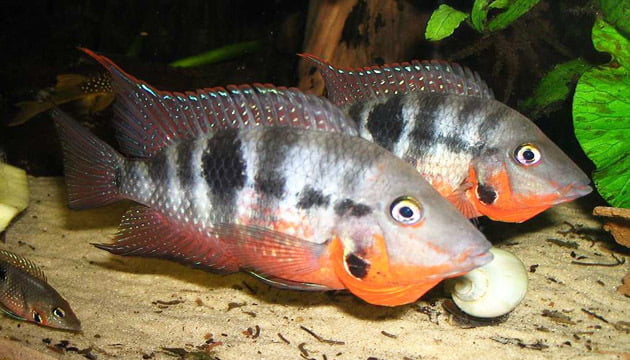
Firemouth
The Firemouth Cichlid (Thorichthys meeki) is a popular freshwater fish species among aquarium enthusiasts. Here are some key characteristics and information about the Firemouth Cichlid:
Origin: Native to Central America, specifically found in the Yucatan Peninsula in Mexico, Belize, Guatemala, and Honduras.
Appearance: The Firemouth Cichlid is known for its striking appearance. It has a somewhat oval-shaped body with a distinctive red coloration on its throat and lower jaw, giving it the "firemouth" name. The body is generally silver or gray with iridescent scales, and the fins may have red or orange highlights.
Size: Adult Firemouth Cichlids typically reach a size of 6 to 8 inches (15 to 20 cm) in length, with males being slightly larger than females.
Aquarium Requirements: To keep Firemouth Cichlids in captivity, it's recommended to provide them with a tank of at least 30 gallons (113 liters). They appreciate a setup with plenty of hiding spots, such as caves and driftwood. The aquarium should also have a sandy substrate, as they like to dig.
Water Parameters: Firemouth Cichlids prefer slightly alkaline water with a pH range of 7.0 to 8.0 and a water temperature between 75 to 82 degrees Fahrenheit (24 to 28 degrees Celsius).
Behavior: While Firemouth Cichlids can be territorial, they are generally considered to be less aggressive than some other cichlid species. However, during breeding or if space is limited, they may become more assertive. It's advisable to keep them with tankmates of similar size and temperament.
Diet: Firemouth Cichlids are omnivores and will accept a varied diet. A combination of high-quality pellets, live or frozen foods like brine shrimp or bloodworms, and some vegetable matter should be provided.
Breeding: Firemouth Cichlids are known to be good parents. During breeding, the female will lay eggs on a flat surface, and both parents will actively participate in guarding and caring for the fry.
It's essential to research and understand the specific needs of Firemouth Cichlids before keeping them in an aquarium. Proper care, attention to water quality, and a suitable tank setup are crucial for their well-being.



